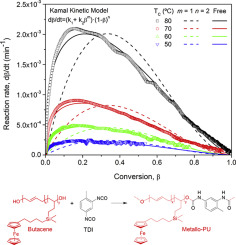Polymer ( IF 4.1 ) Pub Date : 2018-02-26 , DOI: 10.1016/j.polymer.2018.02.058 Beatriz Lucio , José Luis de la Fuente

|
The reaction of 2,4-toluenediisocyanate (2,4-TDI) and a metallocenic-prepolymer derived from hydroxyl-terminated polybutadiene (HTPB) was studied in bulk and under isothermal conditions (50–80 °C) by rheological methods. Two regions distinguished and limited by the gel point, identified as the crossover of loss tangent (tan δ) at different frequencies, were analysed from different rheological properties during the curing process of this novel metallo-polyurethane (PU). The initial part of this polymerization, dominated by the viscous behaviour (from η0 ≈ 5 Pa s to η = 250 Pa s), was modelled through the Arrhenius isothermal model, in which the presence of two rheokinetic stages, due to different isocyanate groups in the 2 and 4 positions for this asymmetric monomer, was found until the gelation is reached. The contributions of the main reactions for the region analysed, before the gel point of this polyaddition, are discussed. The gel transition was identified, and the viscoelastic behaviour of the gelation process was studied in depth. In addition, from the evolution of the storage modulus (G′) recorded, the overall polymerization reaction was described by a Kamal-Sourour kinetic expression for the reaction rate. The different kinetic parameters obtained for the autocatalytic model used yielded predictions that agree very well with the experimental data, finding a significant autocatalytic effect. An isoconversional method allowed the determination of the dependence of the activation energy on the conversion degree during the network formation of this advanced functional ferrocene-PU, which is of great interest in rocket technology research for the development of the aerospace industry.
中文翻译:

2,4-甲苯二异氰酸酯和二茂铁官能化的羟基封端的聚丁二烯聚合的动力学和化学流变学模型
通过流变方法研究了2,4-甲苯二异氰酸酯(2,4-TDI)与衍生自羟基封端的聚丁二烯(HTPB)的茂金属预聚物的反应。在这种新型金属聚氨酯(PU)的固化过程中,从不同的流变特性分析了两个由胶凝点区分和限制的区域,即在不同频率下的损耗角正切(tanδ)的交点。该聚合的初始部分,由粘性行为(从主导η 0 ≈5·s至η = 250 Pa s),是通过Arrhenius等温模型建模的,在该模型中,由于该不对称单体在2和4位上存在不同的异氰酸酯基,存在两个流变动力学阶段,直至达到胶凝状态。讨论了该加成物的胶凝点之前主要反应对所分析区域的贡献。确定了凝胶转变,并深入研究了凝胶化过程的粘弹性行为。另外,从储能模量(G')记录下,整个聚合反应用反应速率的Kamal-Sourour动力学表达式描述。使用的自动催化模型获得的不同动力学参数得出的预测与实验数据非常吻合,发现了显着的自动催化作用。等转化方法可以确定这种先进的功能性二茂铁-PU的网络形成过程中活化能对转化度的依赖性,这在航空航天工业发展的火箭技术研究中引起了极大的兴趣。











































 京公网安备 11010802027423号
京公网安备 11010802027423号